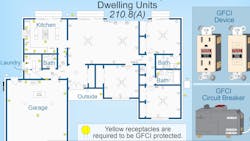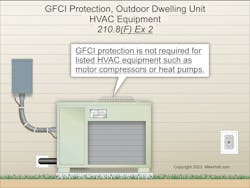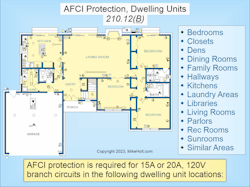A ground fault circuit interrupter (GFCI) protects people from shock, while an arc fault circuit interrupter (AFCI) protects people from fires that could result from electrical arcing of wiring inside walls. Following the NEC rules will optimize protection, while noncompliance could prove fatal to occupants.
GFCI protection for dwellings
GFCI protection must be provided as required in Sec. 210.8(A) through (F). GFCI protective devices must be in a readily accessible location.
You can provide the GFCI protection using either a GFCI circuit breaker or a GFCI receptacle. To apply Sec. 210.8(A)(8) or (10), Sec. 210.8(B)(7), (13), and (15), the distance you measure from the sink or bathtub/shower is the shortest path the power-supply cord connected to the receptacle will follow without piercing a floor, wall, ceiling, or fixed barrier.
With the 2023 revision, the reference to windows and doors was removed to ensure GFCI protection for receptacles within the measured distance as required in Sec. 210.8 even if the measurement line passes through a window or door.
A GFCI circuit breaker provides ground-fault protection starting at the breaker, so the entire circuit has ground-fault protection. A GFCI receptacle provides ground-fault protection for whatever is plugged into it; it has load-side terminals that provide downstream protection for any other receptacle(s) or device(s) on the circuit.
Receptacles installed in the following dwelling unit locations must be GFCI protected — and the GFCI device must be in a readily accessible location (Sec. 210.24(A), as shown in Fig. 1).
(1) Bathrooms.
(2) Garages and accessory buildings.
(3) Outdoors.
(4) Crawl spaces (at or below grade).
(5) Basements.
(6) Kitchens.
Traditionally, this requirement applied only to kitchen countertop receptacles, but now any cord- and plug-connected appliance in the kitchen, such as the range receptacle, refrigerator receptacle, disposal receptacle, and microwave receptacle, now require GFCI protection.
(7) Food or beverage preparation or cooking areas.
(8) Sinks (receptacles within 6 ft of the top inside edge of the bowl of a dwelling unit sink).
(9) Boathouses.
The Code does not require installing a receptacle in a boathouse, but any that are in a boathouse must be GFCI protected.
(10) Bathtubs or shower stalls (receptacles within 6 ft of the outside edge of a bathtub or shower stall not installed within a bathroom).
(11) Laundry areas.
(12) Damp and Wet Locations Indoors.
Exception No. 1: GFCI protection is not required for a receptacle dedicated to fixed electric snow-melting equipment if the receptacle is not readily accessible and ground-fault protection of equipment (GFPE) is provided as required by Sec. 426.28 and Sec. 427.22.
Exception No. 2: GFCI protection is not required for a receptacle supplying only a permanently installed premises security system.
Exception No. 4: GFCI protection is not required for receptacles in dwelling unit bathroom exhaust fans unless specified by the fan instructions.
The receptacle for exhaust fans is internal to the exhaust fan. They are not accessible as a convenience cord-and-plug receptacle; therefore GFCI protection is not required. Per “UL Guide Information GPWX,” exhaust fans installed in the area directly above the footprint (width and depth of the equipment) of the bathtub or shower must be GFCI protected.
GFCI protection for other than dwellings
GFCI protection is required for 125V through 250V receptacles supplied by single-phase branch circuits 50A (or less) or 3-phase branch circuits 100A (or less) installed in the following locations [Sec. 210.8(B)]:
(1) Bathrooms.
(2) Kitchens.
(3) Food or beverage preparation or cooking areas.
(4) Buffet serving areas (if they have permanent provisions for food serving, beverage serving, or cooking). This requires GFCI protection for receptacles in the break area of a commercial occupancy.
(5) Rooftops.
(6) Outdoors.
(7) Sinks (for cord- and plug-connected fixed or stationary appliances within 6 ft from the top inside edge of the bowl of a sink). Note that a faulted appliance in proximity to sinks presents a shock hazard whether the receptacle is within 6 ft or not.
(8) Indoor damp or wet locations.
(9) Locker rooms.
(10) Garages, accessory buildings, and similar areas.
(11) Crawl spaces (at or below grade).
(12) Unfinished areas of basements.
(13) Aquatic tanks or bowls (receptacles within 6 ft from the top inside edge or rim, and receptacles within 6 ft from the conductive support framing of the container for aquariums, bait wells, and similar open aquatic containers such as tanks or bowls).
(14) Laundry areas.
(15) Bathtubs and shower stalls (receptacles within 6 ft of the outside edge of a bathtub or shower stall not installed in a bathroom).
Exception No. 2: Rooftop GFCI receptacles are required to be readily accessible only from the rooftop itself.
GFCI protection is also required for:
- 120V lighting outlets in crawl spaces [Sec. 210.8(C)]. A lighting outlet is not required for a dwelling unit crawl space unless the space is used for storage or has equipment requiring servicing [Sec. 210.70(C)].
- Appliances rated 150V or less to ground, rated 60A or less, single- or three-phase, either cord-and-plug or hardwired connected. A dozen of these are listed in [Sec. 210.8(D)]. They include vending machines, sump pumps, and electric ranges. Some appliances listed in 210.8(D) may be hardwired instead of cord- and plug-connected, but the GFCI protection requirements of Sec. 210.8(A) and (B) apply only to receptacles. So why are these also required to be GFCI-protected? Because the shock hazards exist whether appliances are hardwired or cord-and-plug connected. Provide GFCI protection for the appliance branch circuit or outlet, either way.
- Equipment requiring servicing [Sec. 210.8(E)]. This includes the 125V, 15A, or 20A service receptacle outlet installed within 25 ft of the air-conditioning equipment as required in Sec. 210.63(A) or indoor service equipment as required in Sec. 210.63(B).
- All outdoor outlets rated 50A or less located outside a dwelling and outside garages, accessory buildings, or boathouses of dwelling spaces. If equipment connected to any of the above outdoor outlets is replaced, the circuit to the outlet must be GFCI-protected.
Exception No. 2: GFCI protection is not required for listed HVAC equipment, such as motor compressors or heat pumps (Fig. 2).
AFCIs
An AFCI is intended to de-energize the circuit when it detects the current waveform characteristics unique to an arcing fault [Art. 100].
AFCI protection is required per Sec. 210.12(B) through (C) and the AFCI device must be in a readily accessible location. AFCI protection is not required for outlets in bathroom areas, garages, or outside. But it is required for 15A or 20A, 120V branch circuits in the following dwelling unit locations [Sec. 210.12(B)]:
(1) Kitchens
(2) Family rooms
(3) Dining rooms
(4) Living rooms
(5) Parlors
(6) Libraries
(7) Dens
(8) Bedrooms
(9) Sunrooms
(10) Recreation rooms
(11) Closets
(12) Hallways
(13) Laundry areas
(14) Similar areas
AFCI protection is required for 15A or 20A, 120V branch circuits in the following dormitory unit locations [Sec. 210.12(C)] (Fig. 3):
(1) Bedrooms
(2) Living rooms
(3) Hallways
(4) Closets
(5) Bathrooms
(6) Similar rooms
AFCI protection is required for 15A and 20A, 120V branch circuits in the following “other occupancy” locations Sec. 210.12(D)]:
(1) Guest rooms and guest suites of hotels and motels.
(2) Nursing homes and limited care facilities, areas used exclusively as patient sleeping rooms.
(3) Areas designed for use exclusively as sleeping quarters in fire stations, police stations, ambulance stations, rescue stations, ranger stations, and similar locations.
If 15A or 20A, 120V branch-circuit wiring is extended, modified, or replaced in any of the areas specified in Sec. 210.12(B), (C), or (D), the wiring must be AFCI protected by one of the following [Sec. 210.12(E)]:
(1) AFCI circuit breaker.
(2) AFCI receptacle installed at the first receptacle outlet of the existing branch circuit.
Exception: AFCI protection is not required for extension wiring that is less than 6 ft long if no outlets or devices, other than splicing devices, are added. This measurement does not include the conductors inside an enclosure, cabinet, or junction box.
Ensuring compliance
When reviewing installation plans, double-check those plans against the “why” behind the Code requirements.
Ask yourself if a person is likely to interact with the branch circuit by plugging things in. If so, the Code probably requires GFCI protection. With an AFCI, the original question was whether people might not detect arcing in the branch circuit due to being asleep. The concept has expanded somewhat, but unawareness of the hazard is still the main driver.
These materials are provided by Mike Holt Enterprises in Leesburg, Fla. To view Code training materials offered by this company, visit www.mikeholt.com/code.
About the Author

Mike Holt
Mike Holt is the owner of Mike Holt Enterprises (www.MikeHolt.com), one of the largest electrical publishers in the United States. He earned a master's degree in the Business Administration Program (MBA) from the University of Miami. He earned his reputation as a National Electrical Code (NEC) expert by working his way up through the electrical trade. Formally a construction editor for two different trade publications, Mike started his career as an apprentice electrician and eventually became a master electrician, an electrical inspector, a contractor, and an educator. Mike has taught more than 1,000 classes on 30 different electrical-related subjects — ranging from alarm installations to exam preparation and voltage drop calculations. He continues to produce seminars, videos, books, and online training for the trade as well as contribute monthly Code content to EC&M magazine.




